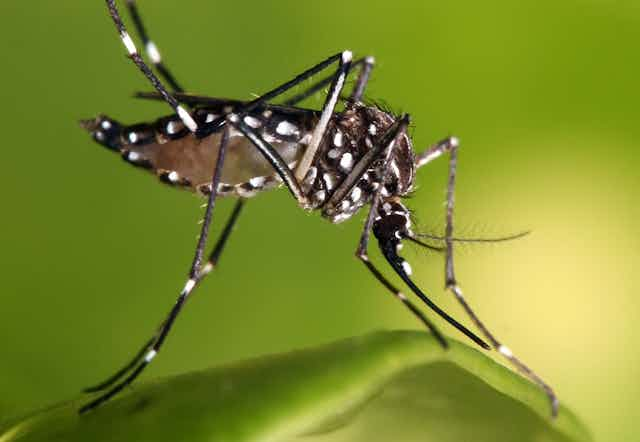Mosquitoes have been described as the most dangerous animals in the world due to their role in spreading diseases such as malaria, dengue, chikugunya and yellow fever. Hundreds of millions of people are infected every year, leading to many hundreds of thousands of deaths.
One of the biggest concerns this year has been the rapid spread of Zika, another virus in the same family as dengue and the yellow fever viruses. There is no vaccine available that is able to protect people from Zika infection at present, and no known cure. So the challenge is to prevent the means of infection: the bite of the mosquito, Aedes aegypti.
Unlike other species of mosquito that transmit the malaria parasite, Aedes mosquitoes bite during the day, which means sleeping under a net offers little protection. Insecticides have been effective but resistance develops rapidly, and public health programmes that target and remove mosquito breeding sites are expected to be difficult to sustain. This has led to a sophisticated new approach that uses one species of parasite to prevent the spread of another.
Bacteria vs virus
The parasites in question belong to a group of bacteria called Wolbachia. These naturally infect a great number of insect species, in which they inhabit tissues including the insect’s ovaries. From here they infect the developing eggs, and so are passed on to the next generation. Although it’s only female insects that can pass the bacteria on to their offspring, the bacteria can reduce the reproductive capability of both male and female hosts. Depending upon the species of Wolbachia, this can lead to sterility, or to swing the sex ratio of offspring in favour of females – which in turn means Wolbachia will spread more rapidly through the insect population through successive generations of infected eggs.
However, Wolbachia infection is not all bad news for insects: there is evidence that Wolbachia also prevents other pathogens from developing in host insects.
For several years, an Australian research group led by Scott O’Neill has taken advantage of this as a strategy to control the spread of dengue viruses. But in order to use Wolbachia to prevent other pathogens from infecting Aedes mosquitoes, first they had to overcome a big hurdle because Aedes are not naturally infected with Wolbachia.
Using very fine needles, they were able to inject Wolbachia from other insects into newly laid Aedes eggs. The bacteria survived inside the mosquitoes that hatched from the eggs, and began to spread naturally through further generations of their lab mosquito colony. When those mosquitoes infected with Wolbachia were subsequently infected with dengue, the dengue virus was not able to replicate and spread to the mosquito’s salivary glands – and so the mosquitoes could not transmit dengue.
Subsequent research has demonstrated that the same technique using Wolbachia also reduces the ability of Aedes mosquitoes to transmit the viruses that cause yellow fever, chikungunya and Zika – and there is some evidence that it can inhibit transmission of the malaria parasite in other mosquito species. The mechanism by which Wolbachia infection does this is not clear, but it’s likely that it involves a change to the mosquito’s immune system.

Weaponising mosquitoes
Unlike the viruses, Wolbachia bacteria are too big to pass through the mosquito’s salivary duct when she bites a human, so there’s no chance that Wolbachia-infected mosquitoes can spread Wolbachia to humans – indeed, Wolbachia is not dangerous to humans. Stringent independent risk assessments have concluded that these mosquitoes were of negligible risk to humans or the environment, so trial releases of these mosquitoes have now taken place in Australia. By breeding with wild Aedes, the infected mosquitoes have rapidly spread Wolbachia throughout the population. The Eliminate Dengue project has now also released mosquitoes in Indonesia, Vietnam, Colombia and Brazil.
In Brazil, the positive results from two pilot releases of Wolbachia-carrying mosquitoes have led to plans to expand the programme across the Rio de Janeiro and Niterói regions and monitor the effects on mosquito-borne viral infections. Facilities there are capable of producing 10m Wolbachia-infected Aedes eggs for release every week.
In the US, the Mosquito Mate project is using a similar technique but instead aims to reduce the number of biting mosquitoes in an area rather than preventing the spread of disease. Using a different species of Wolbachia that causes sterility in the Asian tiger mosquito (Aedes albopictus), the project has released Wolbachia-carrying male mosquitoes which mate with wild females. As no fertile eggs result, the mosquito population declines. However, unlike the Eliminate Dengue strategy, this approach requires continual releases of mosquitoes because this strain of Wolbachia cannot spread naturally within the mosquito population.
Because Wolbachia-carrying mosquitoes are regarded as biopesticides, Mosquito Mate quickly got regulatory approval by the US Environmental Protection Agency. This is in contrast to the experience of firms such as Oxitec which use genetically modified male mosquitoes that are sterile.
It may take several years to determine whether either of these strategies actually reduces or even eliminates the spread of mosquito-borne viral diseases – but if successful the implications for the millions affected by these diseases worldwide are enormous.

